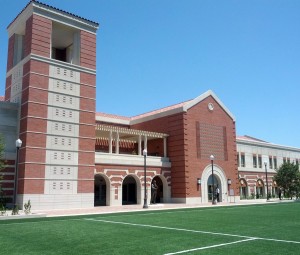USC completes work on $70 million McKay Center
The patio view from the head coach’s suite at USC’s recently erected John McKay Center overlooks Howard Jones Field, where the football team practices.

State of the art · USC’s new 110,000-square-foot athletic facility, the John McKay Center is equipped with a larger weight room and is more than twice the size of Heritage Hall, which opened its doors in 1971. – Ralf Cheung | Daily Trojan
Oddly enough, it’s a view that doesn’t get much use — and won’t anytime soon.
“I’m not allowed to use it, really,” said Lane Kiffin, the Trojans’ coach. “I’m not allowed to watch anything from it because of compliance.”
That second-floor patio on the west end might be the only part of USC’s new $70 million, 110,000-square-foot athletic facility that isn’t getting used around the clock these days. The McKay Center, which officially opened earlier this month after its soft opening on July 23, already houses all 21 varsity sports. The massive facility stands more than twice the size of Heritage Hall, the previous athletic complex opened in 1971.
“I think there’s a wow factor for sure when people enter the building, just because it’s so dramatically different from what they’re used to,” said Senior Associate Athletic Director Mark Jackson, who played a key role in overseeing the project.
The McKay Center, which broke ground in January 2011, has been a long time coming for the athletic department. The last similar on-campus athletic facility to be built at USC was Heritage Hall, which opened more than four decades ago. And the idea for the McKay Center originated as far back as 2002, but was delayed in large part because of construction to the 255,000-square-foot 10,258-seat Galen Center, according to Jackson.
“It’s something that’s been long overdue,” Jackson said. “So from an efficiency and functionality standpoint, it just makes everyone’s job much easier.”
The McKay Center features three levels: a 60,000-square-foot, underground basement that includes training and weight rooms, a football locker room and a 40-yard AstroTurf practice field. The weight room stands eight times the size of the previous one. The ground level consists entirely of academic support programs and the second floor boasts a number of football offices, team meeting rooms and a players’ lounge.
“It’s really great for our players to have all their academics right there, the training room, everything,” Kiffin said. “It’s very convenient for us coaches too. I can’t imagine there’s a better one.”
As evidenced by the project, USC has made great strides to keep up with its Pac-12 counterparts, as a number of universities have made similar efforts to upgrade their football and athletic facilities over the last couple years.
“You always have to stay competitive with your competition,” Jackson said. “But for us, a lot of it was done out of need. The functionality of that space [in Heritage Hall] doesn’t lend itself at all to having a top-tier program.”
Elsewhere out west, schools have spent more than half a billion dollars on athletic facilities. The University of Arizona is in the middle of a $378 million expansion project near the north end zone at its on-campus stadium, which will add approximately 7,000 seats. UC Berkeley’s renovated Memorial Stadium, a project with an estimated price tag of $321 million, will open next month for its Sept. 1 opener against University of Nevada, Reno. University of Utah is building a $30-million football complex and The University of Washington’s Husky Stadium is in the middle of $250 million renovation project, as well.
Suffice it to say, most are eager to usher in a new era.
“Beyond normal maintenance needs that prompt renovations, many of the facilities have been long overdue for upgrading to reflect the changing landscape of collegiate athletics,” said Courtney Brunious, assistant director of USC’s Sports Business Institute. “From upgrading locker rooms to adding luxury boxes to satisfy corporate demand and bring in additional revenue, these stadium renovations help create additional interest in the brand, attract athletes and create additional revenue streams.”
These efforts have been aided, in part, by the Pac-12’s new 12-year, $2.7 billion television contract announced in May 2011 that will divide revenue among member institutions. The deal, which takes effect this season, has tripled the conference’s media rights fees.
“The increase in athletic department revenues each school receives from the deal has undoubtedly aided in funding projects that may have been languishing a bit,” Brunious added. “Any increase in revenue is going to help athletic departments in a number of areas, including renovations.”
Foremost for USC, though, the renovations have been directed toward meeting the needs of its athletes, as opposed to simply satisfying corporate demands. And the players, unsurprisingly, have been receptive to the change.
“Man, it’s amazing,” sophomore linebacker Dion Bailey said. “That’s what we’ve been missing out on. It’s light-years ahead of Heritage.”
[Correction: A previous version of this article stated that the McKay Center was 110 square feet. It is 110,000 square feet. The Daily Trojan regrets the error.]
